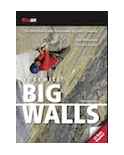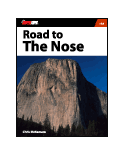Click here to see what is currently on my El Capitan rack.
Retreat, Bailing and Fear Management
Storms, and not being prepared to weather them, is the number one way climbers die on walls. A whole book could be written on this subject so I will just stick to basics and refer you to one very important resource: “Staying Alive” by John Dill, which is a free download on the SuperTopo web site: www.supertopo.com/topos/yosemite/stayalive.pdf
Retreating on a big wall is a pain in the ass for one reason: the haul bag. Managing that beast while rapping is tricky and not fun. But rappeling efficiently and safely with a haul bag is a very important skill. If you have to retreat in the rain and snow, with every extra minute you are exposed to the elements while rappeling the danger increases exponentially. As you get colder you lose mobility, make poorer decisions, risk a waterfall forming on top of you and become too cold to move. Know how to bail before you get on the wall! And if you don't actually practive (as I recomend below) then at least do the mental excercise of envisioning how the whole retreat process works. If you have to figure this out for the first time while in a storm… you will be hating life.
Skills to Learn
Gear You Need
Where to Practice
Any cliff where you can rap down to a hanging belay, pull the rope, then rappel again. If you can't find that, just rappel on any old cliff.
Rappeling With a Bag
Rappeling with a bag is a little awkward, but it’s less awkward than the alternative: trying to rap with 60 pounds on your back.
First, whenever you are rappeling, it is a good idea to:
A) Keep your Ascenders clipped to your side in case you need to ascend back up.
B) Keep your daisy chains attached to your Aiders so that you can both safely clip into the anchor and move around a hanging anchor if necessary.
C) Any time you are moving the bag from the anchor to your belay loop, make sure it is backed up somehow so you can't drop it. A daisy chain or sling for the bag itself is a good idea.
The actual process of rappelling with the bag is pretty simple.
Retreat
First, I need to dispel a myth. Some epic big wall stories have a passage like this: “The wall became just too overhanging to retreat. We were totally committed. Summit or the grave. We had to dig deep in the haul bag of our souls for the courage to persevere in the extreme… etc, etc.” While this makes for dramatic story-telling, it is just not true. If you can aid climb up something, then you can aid climb down it. Retreating on traversing and overhanging terrain is a pain in the ass, but it is not impossible.
Retreat Procedure: Three Scenarios
First off, whenever retreating, both climbers should have Ascenders clipped to the side of the harness, extra slings and biners, daisy chains and Aiders. Make sure there is a knot in the end of any rope you are rappelling.
1) If you are familiar with the rappel route and it is straight-forward:
2) If you are unfamiliar with the rappel route or the terrain is traversing or overhanging:
3) If the terrain is REALLY overhanging and/or traversing (only happens in rare cases):
Go Up, Go Down, or Stay Put?
What do you do if a big storm is coming in? Up, down or stay put? The answer will vary depending on your situation but one thing has been proved again and again: most weather-related big wall deaths could have been prevented with the proper gear and better judgment. Proper gear includes synthetic layers, water-proof breathable shells, a portaledge rain-fly (whether you have a portaledge or not), and gloves.
If a storm is coming in, and you know you have time to safely make it the ground or the summit, then go for it! However, if you are not sure you can make it to the ground or the top, then focus on getting to the closest place you think will be sheltered from a waterfall. Once you are in a storm, it is usually more dangerous to retreat than to stay put at an adequate bivvy spot with good gear. When you are either climbing or rappeling, water will get in your jacket, collect at your belay device, and generally you can’t help but get soaked. If you stop, the wind and water may make you so cold you can't move again. And, of course, it doesn't take much for your hands to become so cold they fumble carabiners or don't work at all. More than a few climbers have died just a few pitches from the summit of El Capitan. They may have thought they would stay warmer by climbing or may have wanted to escape what they thought was hopeless situation. But, in general, if you have synthetic gear, rain shells, and some shelter (bivy sack or rain-fly) then you will be more likely to survive be huddling up with your partner than by trying to climb or rappel in bad weather.
The above said, just staying put where you are is not always the best solution. A big danger of being on a big wall in a storm is the formation of waterfalls. Even a relatively small waterfall can be deadly because everything that connects you to the wall is a conduit for water. Being wet is one thing. Having cold water running over you is a whole other level of cold. In general, black streaks on the rock equals a waterfall site in a storm. But even if there are no distinct black streaks, the water can still gather above you and run down in big sheets like on the West Buttress or Lurking Fear on El Capitan.
Bailing for Non-Weather or Non-Safety Related Reasons
Am I bailing because it is smart or because I am temporarily overwhelmed?
Few other activities can bring such sustained uncertainty and excitement as climbing up 2900 feet of vertical rock. It is precisely because climbing El Capitan is such an adventure that you will probably be terrified once you have committed yourself to it. This is natural. Without the process of overcoming such uncertainty, it wouldn’t be such an amazing experience.
Understand that at some point, whether it is racking up in El Cap Meadow or traversing into Stoveleg Crack, you may feel the urge to bail. Every wall climber, including me, experiences this, a lot. At this point you will have to make a critical decision: is the fear you have because you are unprepared and should not continue? Or is it because you are just a little spooked? As aid climbing master Ammon McNeely puts it, “There will be many reasons to bail swirling in your head those first few days. Sometimes success depends on your ability to ignore those reasons.” Here is where all the previous training you have done becomes critical. If you have followed the steps outlined in this book and put in your training, then dread might be just a little healthy fear from being in an unfamiliar situation. Focus on your firm base of big wall skills and the fear will melt away. If you have not adequately prepared, retreating may be the best option. You don’t want to barely scrape your way up what may be on one of the best climbs of your life. You want to climb it confidently and be able to fully appreciate the spectacular pitches. And, of course, if you are truly unprepared, going up on a big wall will put yourself, your partner, and potential rescuers at risk.
Dealing With Fear
Here are five tricks for dealing with minor fear on lead. They are to get you through momentary moments where your fear is working against you. If a giant storm is rolling in and you are unprepared, these don’t help. And in that situation you SHOULD be scared!
Remember
Surviving Storms
To be continued...
Click here to see what is currently on my El Capitan rack




